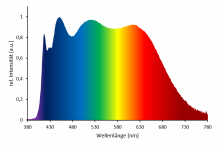Ca++
Well-known member
Shame this isn't it's own thread with a poll.A - Mars
B - HPS
I like the look of group A, the head density is about double.
400x1.7=680 vs 220x2.5=550
I'm going to follow the maths and say
A HPS
B LED
Though it's not a direct comparison, when the HPS is over 20% more ppf + IR




![[Maschinehaus-2021].jpg](/data/attachments/2778/2778133-e93db4a10429c4dac684d0aa5bd09f70.jpg)


